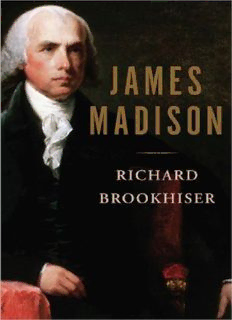
James Madison PDF
Preview James Madison
Table of Contents ALSO BY RICHARD BROOKHISER: Title Page Dedication A NOTE ON SPELLING AND USAGE Acknowledgments Introduction CHAPTER ONE - Youth, Revolution CHAPTER TWO - The Constitution CHAPTER THREE - The Federalist, The Bill of Rights CHAPTER FOUR - The First Political Party CHAPTER FIVE - Leading an Opposition CHAPTER SIX - Wilderness Years CHAPTER SEVEN - In Power CHAPTER EIGHT - Problems of Power CHAPTER NINE - President CHAPTER TEN - War Leader CHAPTER ELEVEN - Retirement, Death EPILOGUE NOTES BIBLIOGRAPHY INDEX Copyright Page ALSO BY RICHARD BROOKHISER: Right Time, Right Place George Washington On Leadership What Would the Founders Do? Gentleman Revolutionary: Gouverneur Morris— The Rake Who Wrote the Constitution America’s First Dynasty: The Adamses 1735–1918 Alexander Hamilton, American Rules of Civility Founding Father: Rediscovering George Washington Way of the WASP The Outside Story FOR Bert and Nina Smiley A NOTE ON SPELLING AND USAGE Eighteenth-century writing had somewhat different rules than today’s, and even the well educated followed them rather loosely. Proper names were often spelled whimsically. In his notes on the Constitutional Convention, Madison wrote of Govurneur (Gouverneur) Morris, Oliver Elseworth (Ellsworth), and Roger Sharman (Sherman). William Pierce, meanwhile, wrote of Mr. Maddison. All spelling and punctuation have been modernized in what follows. American presidents in Madison’s lifetime sent “ministers” abroad, not “ambassadors,” and picked “secretaries of departments,” not a “cabinet.” The newest capital of the United States was called “Washington City,” not “Washington.” I have sometimes preferred anachronism to quaintness. The Republican Party that Jefferson and Madison founded is the ancestor of today’s Democrats; the modern GOP is a different, later organization. ACKNOWLEDGMENTS Michael C. Quinn, president of the Montpelier Foundation, and all his colleagues have been of great help. Michael Pack and Tracy Simmons gave me good advice. The generosity of the John Simon Guggenheim Memorial Foundation helped me complete this book. Akhil Amar, Michael Pack, and Tracy Simmons gave good suggestions and advice. I would like to thank my editor, Lara Heimert, my agent, Michael Carlisle, and my wife, Jeanne Safer. Introduction August 24, 1814, began as a typical summer day in Washington: bright and cloudless, promising heat and humidity as the day wore on. For years, James Madison, the president, had fled high summer in Washington and other lowlying cities for the healthier air of his inland home in the Virginia Piedmont. But this August his presence was required in the capital. America had been at war with Britain for two years. Mr. Madison’s war—he had asked Congress to declare it— had been fought along the Canadian border; against Indians on the frontier; on the high seas. Now the war was coming home. A week earlier, on August 17, twenty British ships carrying 4,500 troops had anchored in the Patuxent River in Maryland, only thirty-five miles away from Washington to the southeast. The president had suggested “pelt[ing] the enemy from the start with light troops.” But nothing was done. Instead the British disembarked and made a leisurely stroll up the Maryland countryside, perhaps bound for Baltimore, a booming port, the third-largest city in America. Secretary of War John Armstrong thought so: they would “certainly” not come to Washington, he said; “what the devil will they do here? . . . No, no! Baltimore is the place, sir.” But now the British had made a left turn. Just hours earlier, at midnight, the president had gotten a note from the field: “The enemy are in full march for Washington.... Destroy the bridges.... Remove the records.” When James Madison had been a congressman, a quarter century earlier, he had helped move the nation’s capital from New York to an undeveloped site on the Potomac. The new capital was still hardly more than a small town, stretching from Rock Creek in the west to Capitol Hill in the east: a ragged arc, decorated by a few incongruous public buildings, as if built by ancients or aliens. In the midst of it stood the White House. Madison was the third president to have lived there. John Adams, whom Madison scorned, had spent the dismal last days of his administration in a shell inside a construction site. Thomas Jefferson, whom Madison loved above all men, had run it like a Virginia plantation house, hosting intimate dinners for congressmen and diplomats with good food, excellent wine, and his own sparkling conversation. Madison’s White House was grander yet, thanks to his wife, Dolley, who brightened it with banquets and soirees, red velvet curtains and green gilt-edged china, a piano and a macaw.
Description: